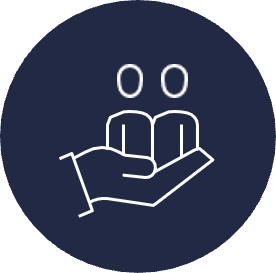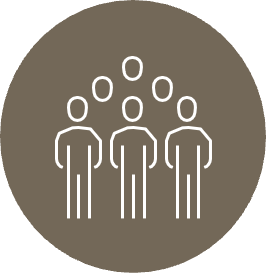Workplace diversity and inclusion
Understanding diversity and inclusion
All of us have a role to play in cultivating a diverse and inclusive workplace. This starts with understanding diversity and inclusion, an awareness of systemic and institutional barriers and being able to recognise non-inclusive behaviours and practices.

Diversity
Diversity includes anything that makes people different and unique. These differences can be more or less visible and include gender, ethnicity, cultural background, disability, age, sexual orientation, religious beliefs and disability.
Diversity also includes other differences such as family responsibilities, educational level, socio-economic background, geographic location and differences in views and opinions.

Inclusion
Inclusion is how we accept and respect all our staff for their diverse and often overlapping characteristics and include their voices in what we do. We do this by embracing diversity, creating an environment that is welcoming to everyone, and values people’s backgrounds, perspectives and lived experiences.
It means creating a climate and culture where people feel they belong and are motivated to work collaboratively to uphold the university’s values and achieve its goals.

Belonging
Belonging is a sense of feeling secure and comfortable, respected and supported, so people can bring their authentic selves to work, contribute openly to all that is going on in the organisation and know that they are appreciated and valued for their individual contributions.
This, along with having an affiliation with peers, teams and the broader organisation and being able to participate fully at work, means our staff can thrive.

Intersectionality
Intersectionality acknowledges that people cannot be defined by a single aspect, such as race, gender or disability and that a person can belong to more than one traditionally under-represented group.
For example, a person may identify as a member of the LGBTIQA+ community and as a person with disability. Intersectionality can lead to multiple overlapping barriers, biases or discrimination. Each person’s experience and challenges are unique and a person should not be ‘reduced to a label’.
Resources and training
The resources below will help you learn about diversity and inclusion, and how to be more curious, inclusive, and respectful of people from diverse backgrounds.
-
Inclusion and diversity training chevron_right
The Equity, Diversity and Inclusion team delivers a range of diversity and inclusion-focused training. Learn more, see upcoming dates and register below.
Topic
Duration
Mode
Overview
Diversity and Inclusion Foundations
60 minutes
Facilitated online
Diversity and Inclusion Foundations is designed to build awareness and provide guidance on how to begin to incorporate diversity and inclusion principles in the workplace. Topics include:
- Understanding diversity, inclusion and intersectionality
- power and privilege
- barriers in the workplace
- transforming awareness into actions.
Unconscious Bias and Inclusivity
90 minutes
Facilitated online
Diverse and inclusive workplaces have stronger teams and achieve better outcomes. However, unconscious bias can our limit acceptance of diversity and lead to non-inclusive behaviours and practices.
This can be overcome by creating awareness of how our unconscious biases impact others and employing strategies to create inclusive workplaces where staff feel that they belong. Topics include:
- Understanding bias
- how bias impacts the workplace
- how bias impacts individuals
- inclusive behaviours
- bystander intervention.
-
Charles Sturt resources for Staff chevron_right
Resource
Focus area
Overview
Inclusive practice
Help staff and students recognise and avoid unintended discriminatory practices in all modes of communication. They suggest common sense principles for ensuring that the way we communicate acknowledges and respects the different experiences, lifestyles and ways of being represented in our diverse community, to support an inclusive and safe work/study environment.
Accessibility and Neurodiversity
Outlines university-wide strategies to prevent and address disability discrimination for current and prospective students and staff.
Accessibility and Neurodiversity
Outlines Charles Sturt's commitment to providing an accessible and inclusive work and study environment and supports compliance obligations.
Accessibility and Neurodiversity
Describes how to request and implement a workplace adjustment to accommodate a non-work-related injury, medical condition or disability at Charles Sturt.
All key diversity groups
This policy sets out Charles Sturt University's commitment to the prevention of bullying, discrimination, harassment, victimisation and vilification. It also provides processes for reporting and the responsibilities of staff and students in relation to these behaviours and types of conduct where they arise.
Bullying, discrimination and harassment prevention procedure
All key diversity groups
This procedure supports the Bullying, discrimination and harassment prevention policy and is intended to assist with identifying these behaviours and outline options for reporting and resolving incidents.
All key diversity groups
This Policy is intended to heighten awareness of domestic violence as an issue that may need to be addressed on campus, and outlines the University's commitment to supporting staff and students who are victims of domestic violence.
All key diversity groups
This document sets out Charles Sturt University's procedure for supporting staff who are victims of domestic violence and addressing the impacts of domestic violence in the workplace.
All key diversity groups
These guidelines provide further explanatory information and details on the operation of the Flexible Working Hours Scheme (the Scheme).
All key diversity groups
The Manual provides further explanatory information (to the current Enterprise Agreement) and details on the taking of leave by employees of the University.
Balancing work and study with family and caring responsibilities policy
Carers
Outlines Charles Sturt University's commitment to providing a flexible, supportive and accessible work/study environment for staff and students with family or caring responsibilities.
Carers
This Policy outlines the conditions that apply to accommodating breastfeeding mothers on Charles Sturt University (the University) campuses.
-
External resources for Staff chevron_right
Resource
Focus area
Overview
Accessibility and Neurodiversity
30 minute podcast from the ABC’s This Working Life series that explores what it’s like being an autistic person in the workplace and how managers and colleagues help this group thrive.
Managing yours and others' ADHD to thrive at work - ABC listen
Accessibility and Neurodiversity
24 minute podcast from the ABC’s This Working Life series that explores ADHD in the workplace and looks at how to create supportive environments for colleagues and managers who have ADHD so everyone thrives.
Accessibility and Neurodiversity
Online learning module (1h 18 mins). In this course, workplace inclusion consultant Tiffany Jameson and neurodivergent and disability inclusion expert Nicole Seaward discuss ways to include and support your autistic colleagues. They show you how to be inclusive in job posts, interviews, onboarding, performance evaluations, and more.
Neurodiversity Hub - Resources for Students, Employers & More
Accessibility and Neurodiversity
An online hub that aims to facilitate a community of practice for universities, colleges, employers and service providers to work together to create these environments and opportunities for neurodivergent young adults.
The Resources section includes a vast array of resources that have been created or curated for use by neurodivergent students, their parents and carers, employers and universities.
Understanding and Supporting ADHD Colleagues in the Workplace
Accessibility and Neurodiversity
Online learning module (1h 7 mins). Learn how ADHD manifests in the workplace and how to apply practices to be an ally for your coworkers and create a workplace where they can do their best work. This course is all about embracing how we each learn differently by focusing on workplace needs from an ADHD lens.
People with Disability Australia: Guide to language about disability
Accessibility and Neurodiversity
The language used to describe disability shapes public perceptions and treatment of individuals with disabilities, influencing societal structures and personal identity.
This guide unpacks the key factors that influence disability-related language, provides advice for reporting on disability-related content, and identifies commonly misused terms and provides suitable alternatives.
Accessibility and Neurodiversity
IncludeAbility, an initiative of the Australian Human Rights Commission, aims to boost employment for people with disabilities and bridge the workforce participation gap.
The resources on this page include guides on creating accessible and inclusive communications, hosting accessible in-person and online meetings and events, and eLearing modules to build your understanding of disability in the workplace.
Carers
2 minute LinkedIn clip explaining the motherhood penalty and fatherhood premium.
Carers; Staff who have a disability or care for someone with disability; Staff aged 55 or older; Pregnant staff; Family and domestic violence.
Government webpage outlining best practice for flexible working arrangements under the Fair Work Act.
Carers
Carers NSW services and support page for carers
Carers
Information from Carers NSW about carers in the workplace. Includes guidance for staff and managers, as well as a conversation guide for negotiating flexible working arrangements, podcasts and links to support services.
Diverse Faith and Culture
4 minute LinkedIn clip defining cultural diversity and why we need to embrace it in the workplace.
Diverse Faith and Culture
34 minute LinkedIn talk about how unconscious bias and assuming similarities affects our interactions with people from diverse cultures.
Diverse Faith and Culture
3 minute LinkedIn clip about factors that affect our viewpoints.
Diverse Faith and Culture
4 minute LinkedIn clip explaining Microaggression examples and how the ‘drops of water effect’ works.
First Nations
This is a website that brings together online resources made by and for First Nations people. Here you will find websites, apps, podcasts, videos, helplines, social media and online programs all with a focus on social and emotional wellbeing.
First Nations
This online learning module covers the systems of social organisations that traditionally govern First Nations Societies and explains cultural differences. It will give you a better understanding of:
- Kinship systems and how they differ from Western societies
- Potential conflict in working with people from differing backgrounds and how these differences impact First Nations people
First Nations
A handbook created with practical advice for managers and supervisors on how they can boost sustained employment for First Nations people.
Gender
4 minute LinkedIn clip that explains gender bias from male and female perspectives-includes unconscious bias and confirmation bias.
Gender
4 minute LinkedIn clip about how male specific words create and reinforce male specific models and why it is important to be more inclusive. The word ‘guys’ is used as an example to show how language can marginalise people.
Gender
4 minute LinkedIn clip about Unconscious bias and the absence of women in many facets of society and how women’s performance is valued differently than men’s.
Inclusive language
Inclusive language is a powerful tool for building workplace inclusion. This PDF resource produced by the Diversity Council of Australia is a great starting point for learning about inclusive language and communication.
Championing Inclusion: A Guide to Creating LGBTI Inclusive Organisations
LGBTIQA+, LGBTIQA+ Allyship
A guide covering how to be an effective Ally and an active champion for LGBTQ inclusion within the workplace created by the National LGBTI Health Alliance and MindOUT.
International Lesbian, Gay, Bisexual, Trans and Intersex Association world database
LGBTIQA+
Interactive database that lets you explore the state of LGBTIQA+ inclusion in different jurisdictions across the world.
LGBTIQA+
A 3-part ABC documentary that provides a historic look at the Queer history of Australia. Each episode runs for approximately 1-hour.
LGBTIQA+, Gender
Microsoft support article and video that demonstrates how to add your pronouns to MS Teams and your MS Office365 profile.
LGBTIQA+, Inclusive language
LGBTIQA+ Inclusive Language Guide for the Workplace from the Equality Project. Includes guidance on fostering inclusive language, pronouns, FAQs and information on terms to avoid.
LGBTIQA+, LGBTIQA+ Allyship
A wealth of resources, guides and information from LGBTQIA+ Youth Organisation Minus 18!
Includes guides on being an active LGBTIQA+ ally, how to be a great trans ally and why particular dates are important to LGBTIQA+ communities.LGBTIQA+ Allyship
Harvard Business Review article with research-based guidance to help you be a better ally to your LGBTQ+ colleagues (and not just perform allyship).
LGBTIQA+, Gender
ABC series that asks outrageous, uncomfortable and shocking questions to uncover the truth behind some of the most marginalised and misunderstood Australians.
Relevant episodes include: Transgender (series 1), Children of Same-Sex Parents (series 2), Drag (series 3), Intersex (series 4), Lesbians (series 6) and Gay Men (series 7).
LGBTIQA+, Gender
ACON’s digital information and resource platform for all trans and gender diverse (TGD) people in NSW, their loved ones, allies and health providers. Contains a wealth of resources including a trans-affirming language guide and glossary, legal and health resources and links to support and further information.
-
External resources for managers chevron_right
Resource
Focus area
Overview
Accessibility and Neurodiversity
National hub for workplace and employment information for people with disability, employers and service providers. Includes information and resources that can drive disability employment in Australia.
Accessibility and Neurodiversity
Financial assistance to eligible people with disability and mental health conditions and employers fund workplace adjustments. Available to eligible people with disability who are about to start a job, are self-employed or who are currently working.
Accessibility and Neurodiversity
Information, advice and resources service on anti-discrimination in New South Wales.
Accessibility and Neurodiversity
The Australian Human Rights Commission protects and promotes human rights in Australia and internationally. Includes guidelines, standards and action plans focused on disability inclusion.
Diverse Faith and Culture
Dept. Of Families, Community Services and Indigenous Affairs fact sheet on culturally appropriate communication.
Diverse Faith and Culture
Explanation of employer’s rights and responsibilities around religion in the workplace.
Diversity and Inclusion
NSW Govt. fact sheets on anti-discrimination by diversity type e.g. age, race, marital status, sexuality etc.
Diversity, Inclusion and Belonging
35 minute LinkedIn course that gives an overview of DIBs including what it means, how to be inclusive and equitable, tools and tips for managers.
First Nations
A webpage about First Nations culture, their practices and how stakeholders can respectfully learn and engage with First Nations people.
Gender
The Status of Women report card shows the challenges women and girls in Australia face through youth and young adulthood, in careers and working life, through parenthood and families, and in later life. It looks at education, economic outcomes, health, safety and wellbeing, housing and gender norms.
Gender
The Workplace Gender Equality Agency is an Australian Government statutory agency created by the Workplace Gender Equality Act 2012 where you can find out what workplace gender equality is, how it affects all of us, and how we can make workplaces better for everyone.
-
Diversity Council Australia member resources chevron_right
Charles Sturt University is a Diversity Council Australia (www.DCA.org.au) member. As a member of DCA, all employees have free access to:
- Unique research | access research and tools on topical diversity & inclusion workplace issues
- Free (online) events | attend thought-provoking events exploring key diversity & inclusion topics
- Curated resources | Build your knowledge about diversity & inclusion best practice
Log in using your work email to access member-only research, events and resources.
Playing our part
The success of our Workplace Diversity and Inclusion Plan depends on the support of everyone in the university. We all have a role to play in building a workplace that values diversity and shows a commitment to inclusion through our attitudes, actions and behaviours.
All staff
- Be curious, gain knowledge and understanding.
- Be self-aware and consider how your words and actions impact others.
- Treat people with dignity and respect, help others to thrive at work.
- Get involved and support diversity and cultural events and initiatives.
- Celebrate different cultures, beliefs and ideas.
- Keep your equity and diversity data updated in our HR systems (so we can better understand your needs and tailor services and support).
Managers, supervisors and team leaders
- Stay informed of relevant diversity and inclusion legislation.
- Be familiar with university diversity and inclusion policy and procedures.
- Value diversity as a team strength and strive to create an inclusive culture.
- Recognise and reward inclusive behaviour and practices.
- Be aware of potential unconscious bias or non-inclusive practices.
- Address behaviour not aligned with university values or code of conduct.
- Support staff to be involved in Employee Networks, forums and consultation.
- Be aware of team needs and support workplace flexibility, including reasonable adjustments.
Senior leaders and managers
- Take the lead in championing diversity and inclusion.
- Walk the talk – model inclusive behaviours and practices.
- Use workforce data and actively seek to increase workforce diversity.
- Take action and hold yourself/others to account for diversity and inclusion goals and practices.
- Recognise and reward inclusive behaviour and practices (including through Rewarding Excellence Daily (RED) reward and recognition).

